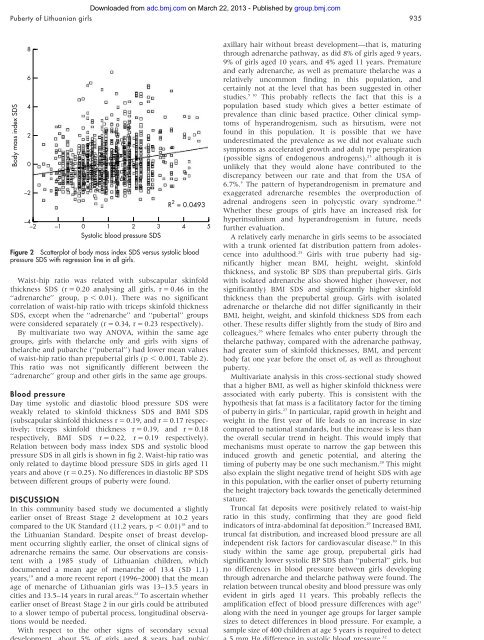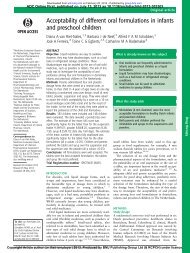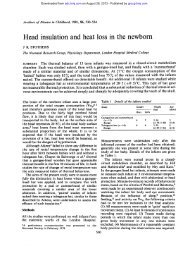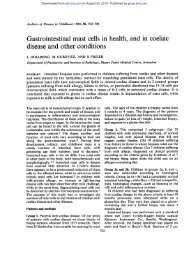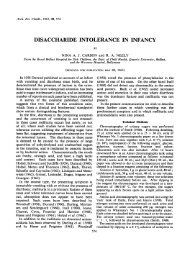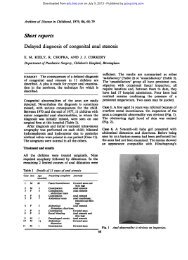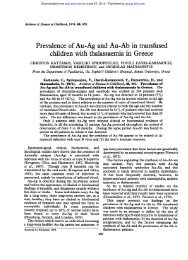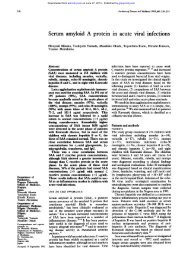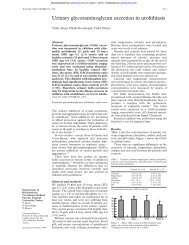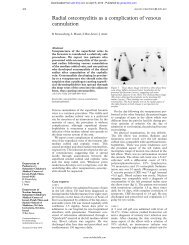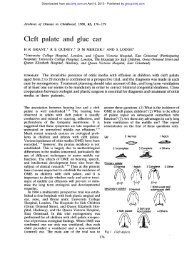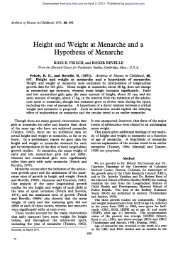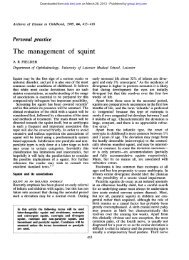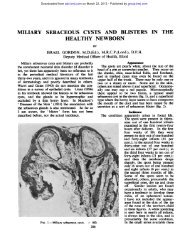Onset of breast and pubic hair development in - Archives of Disease ...
Onset of breast and pubic hair development in - Archives of Disease ...
Onset of breast and pubic hair development in - Archives of Disease ...
Create successful ePaper yourself
Turn your PDF publications into a flip-book with our unique Google optimized e-Paper software.
Body mass <strong>in</strong>dex SDS<br />
8<br />
6<br />
4<br />
2<br />
0<br />
–2<br />
Downloaded from<br />
adc.bmj.com on March 22, 2013 - Published by group.bmj.com<br />
Puberty <strong>of</strong> Lithuanian girls 935<br />
R 2 = 0.0493<br />
–4<br />
–2 –1 0 1 2 3 4<br />
Systolic blood pressure SDS<br />
Figure 2 Scatterplot <strong>of</strong> body mass <strong>in</strong>dex SDS versus systolic blood<br />
pressure SDS with regression l<strong>in</strong>e <strong>in</strong> all girls.<br />
Waist-hip ratio was related with subscapular sk<strong>in</strong>fold<br />
thickness SDS (r = 0.20 analys<strong>in</strong>g all girls, r = 0.46 <strong>in</strong> the<br />
‘‘adrenarche’’ group, p , 0.01). There was no significant<br />
correlation <strong>of</strong> waist-hip ratio with triceps sk<strong>in</strong>fold thickness<br />
SDS, except when the ‘‘adrenarche’’ <strong>and</strong> ‘‘pubertal’’ groups<br />
were considered separately (r = 0.34, r = 0.23 respectively).<br />
By multivariate two way ANOVA, with<strong>in</strong> the same age<br />
groups, girls with thelarche only <strong>and</strong> girls with signs <strong>of</strong><br />
thelarche <strong>and</strong> pubarche (‘‘pubertal’’) had lower mean values<br />
<strong>of</strong> waist-hip ratio than prepubertal girls (p , 0.001, Table 2).<br />
This ratio was not significantly different between the<br />
‘‘adrenarche’’ group <strong>and</strong> other girls <strong>in</strong> the same age groups.<br />
Blood pressure<br />
Day time systolic <strong>and</strong> diastolic blood pressure SDS were<br />
weakly related to sk<strong>in</strong>fold thickness SDS <strong>and</strong> BMI SDS<br />
(subscapular sk<strong>in</strong>fold thickness r = 0.19, <strong>and</strong> r = 0.17 respectively;<br />
triceps sk<strong>in</strong>fold thickness r = 0.19, <strong>and</strong> r = 0.18<br />
respectively, BMI SDS r = 0.22, r = 0.19 respectively).<br />
Relation between body mass <strong>in</strong>dex SDS <strong>and</strong> systolic blood<br />
pressure SDS <strong>in</strong> all girls is shown <strong>in</strong> fig 2. Waist-hip ratio was<br />
only related to daytime blood pressure SDS <strong>in</strong> girls aged 11<br />
years <strong>and</strong> above (r = 0.25). No differences <strong>in</strong> diastolic BP SDS<br />
between different groups <strong>of</strong> puberty were found.<br />
DISCUSSION<br />
In this community based study we documented a slightly<br />
earlier onset <strong>of</strong> Breast Stage 2 <strong>development</strong> at 10.2 years<br />
compared to the UK St<strong>and</strong>ard (11.2 years, p , 0.01) 18 <strong>and</strong> to<br />
the Lithuanian St<strong>and</strong>ard. Despite onset <strong>of</strong> <strong>breast</strong> <strong>development</strong><br />
occurr<strong>in</strong>g slightly earlier, the onset <strong>of</strong> cl<strong>in</strong>ical signs <strong>of</strong><br />
adrenarche rema<strong>in</strong>s the same. Our observations are consistent<br />
with a 1985 study <strong>of</strong> Lithuanian children, which<br />
documented a mean age <strong>of</strong> menarche <strong>of</strong> 13.4 (SD 1.1)<br />
years, 19 <strong>and</strong> a more recent report (1996–2000) that the mean<br />
age <strong>of</strong> menarche <strong>of</strong> Lithuanian girls was 13–13.5 years <strong>in</strong><br />
cities <strong>and</strong> 13.5–14 years <strong>in</strong> rural areas. 22 To ascerta<strong>in</strong> whether<br />
earlier onset <strong>of</strong> Breast Stage 2 <strong>in</strong> our girls could be attributed<br />
to a slower tempo <strong>of</strong> pubertal process, longitud<strong>in</strong>al observations<br />
would be needed.<br />
With respect to the other signs <strong>of</strong> secondary sexual<br />
<strong>development</strong>, about 5% <strong>of</strong> girls aged 8 years had <strong>pubic</strong>/<br />
5<br />
axillary <strong>hair</strong> without <strong>breast</strong> <strong>development</strong>—that is, matur<strong>in</strong>g<br />
through adrenarche pathway, as did 8% <strong>of</strong> girls aged 9 years,<br />
9% <strong>of</strong> girls aged 10 years, <strong>and</strong> 4% aged 11 years. Premature<br />
<strong>and</strong> early adrenarche, as well as premature thelarche was a<br />
relatively uncommon f<strong>in</strong>d<strong>in</strong>g <strong>in</strong> this population, <strong>and</strong><br />
certa<strong>in</strong>ly not at the level that has been suggested <strong>in</strong> other<br />
studies. 5 10 This probably reflects the fact that this is a<br />
population based study which gives a better estimate <strong>of</strong><br />
prevalence than cl<strong>in</strong>ic based practice. Other cl<strong>in</strong>ical symptoms<br />
<strong>of</strong> hyper<strong>and</strong>rogenism, such as hirsutism, were not<br />
found <strong>in</strong> this population. It is possible that we have<br />
underestimated the prevalence as we did not evaluate such<br />
symptoms as accelerated growth <strong>and</strong> adult type perspiration<br />
(possible signs <strong>of</strong> endogenous <strong>and</strong>rogens), 23 although it is<br />
unlikely that they would alone have contributed to the<br />
discrepancy between our rate <strong>and</strong> that from the USA <strong>of</strong><br />
6.7%. 5 The pattern <strong>of</strong> hyper<strong>and</strong>rogenism <strong>in</strong> premature <strong>and</strong><br />
exaggerated adrenarche resembles the overproduction <strong>of</strong><br />
adrenal <strong>and</strong>rogens seen <strong>in</strong> polycystic ovary syndrome. 24<br />
Whether these groups <strong>of</strong> girls have an <strong>in</strong>creased risk for<br />
hyper<strong>in</strong>sul<strong>in</strong>ism <strong>and</strong> hyper<strong>and</strong>rogenism <strong>in</strong> future, needs<br />
further evaluation.<br />
A relatively early menarche <strong>in</strong> girls seems to be associated<br />
with a trunk oriented fat distribution pattern from adolescence<br />
<strong>in</strong>to adulthood. 25 Girls with true puberty had significantly<br />
higher mean BMI, height, weight, sk<strong>in</strong>fold<br />
thickness, <strong>and</strong> systolic BP SDS than prepubertal girls. Girls<br />
with isolated adrenarche also showed higher (however, not<br />
significantly) BMI SDS <strong>and</strong> significantly higher sk<strong>in</strong>fold<br />
thickness than the prepubertal group. Girls with isolated<br />
adrenarche or thelarche did not differ significantly <strong>in</strong> their<br />
BMI, height, weight, <strong>and</strong> sk<strong>in</strong>fold thickness SDS from each<br />
other. These results differ slightly from the study <strong>of</strong> Biro <strong>and</strong><br />
colleagues, 26 where females who enter puberty through the<br />
thelarche pathway, compared with the adrenarche pathway,<br />
had greater sum <strong>of</strong> sk<strong>in</strong>fold thicknesses, BMI, <strong>and</strong> percent<br />
body fat one year before the onset <strong>of</strong>, as well as throughout<br />
puberty.<br />
Multivariate analysis <strong>in</strong> this cross-sectional study showed<br />
that a higher BMI, as well as higher sk<strong>in</strong>fold thickness were<br />
associated with early puberty. This is consistent with the<br />
hypothesis that fat mass is a facilitatory factor for the tim<strong>in</strong>g<br />
<strong>of</strong> puberty <strong>in</strong> girls. 27 In particular, rapid growth <strong>in</strong> height <strong>and</strong><br />
weight <strong>in</strong> the first year <strong>of</strong> life leads to an <strong>in</strong>crease <strong>in</strong> size<br />
compared to national st<strong>and</strong>ards, but the <strong>in</strong>crease is less than<br />
the overall secular trend <strong>in</strong> height. This would imply that<br />
mechanisms must operate to narrow the gap between this<br />
<strong>in</strong>duced growth <strong>and</strong> genetic potential, <strong>and</strong> alter<strong>in</strong>g the<br />
tim<strong>in</strong>g <strong>of</strong> puberty may be one such mechanism. 28 This might<br />
also expla<strong>in</strong> the slight negative trend <strong>of</strong> height SDS with age<br />
<strong>in</strong> this population, with the earlier onset <strong>of</strong> puberty return<strong>in</strong>g<br />
the height trajectory back towards the genetically determ<strong>in</strong>ed<br />
stature.<br />
Truncal fat deposits were positively related to waist-hip<br />
ratio <strong>in</strong> this study, confirm<strong>in</strong>g that they are good field<br />
<strong>in</strong>dicators <strong>of</strong> <strong>in</strong>tra-abdom<strong>in</strong>al fat deposition. 29 Increased BMI,<br />
truncal fat distribution, <strong>and</strong> <strong>in</strong>creased blood pressure are all<br />
<strong>in</strong>dependent risk factors for cardiovascular disease. 30 In this<br />
study with<strong>in</strong> the same age group, prepubertal girls had<br />
significantly lower systolic BP SDS than ‘‘pubertal’’ girls, but<br />
no differences <strong>in</strong> blood pressure between girls develop<strong>in</strong>g<br />
through adrenarche <strong>and</strong> thelarche pathway were found. The<br />
relation between truncal obesity <strong>and</strong> blood pressure was only<br />
evident <strong>in</strong> girls aged 11 years. This probably reflects the<br />
amplification effect <strong>of</strong> blood pressure differences with age 31<br />
along with the need <strong>in</strong> younger age groups for larger sample<br />
sizes to detect differences <strong>in</strong> blood pressure. For example, a<br />
sample size <strong>of</strong> 400 children at age 5 years is required to detect<br />
a 5 mm Hg difference <strong>in</strong> systolic blood pressure. 32<br />
www.archdischild.com


